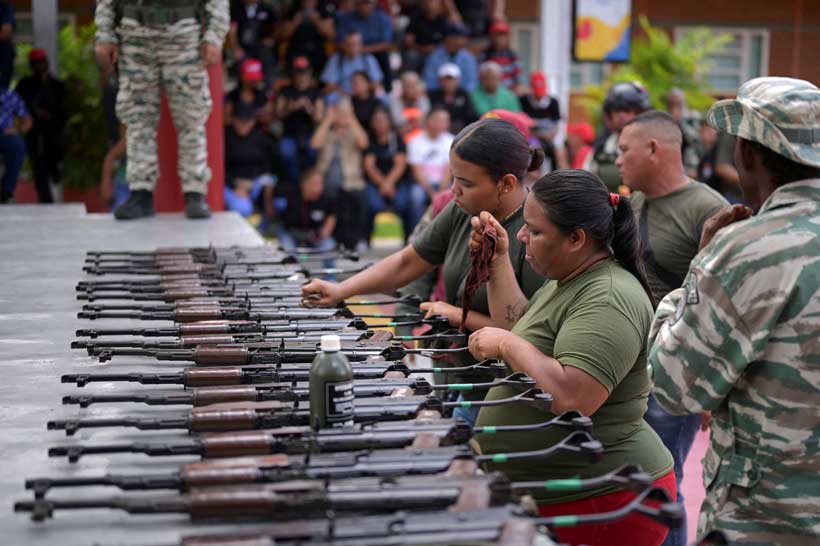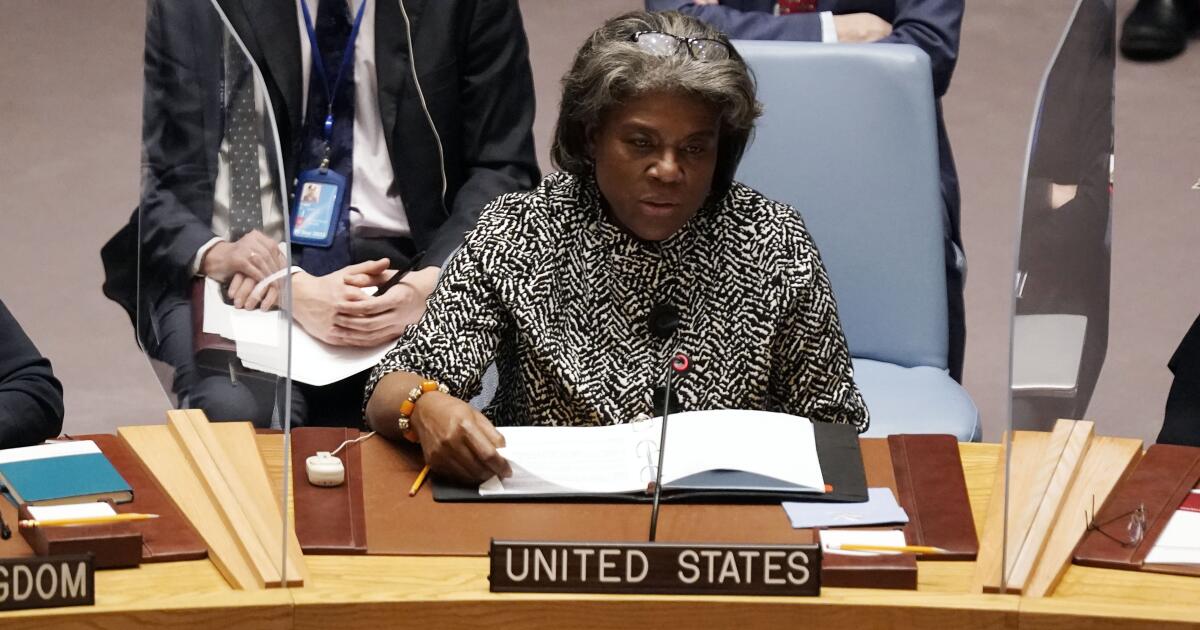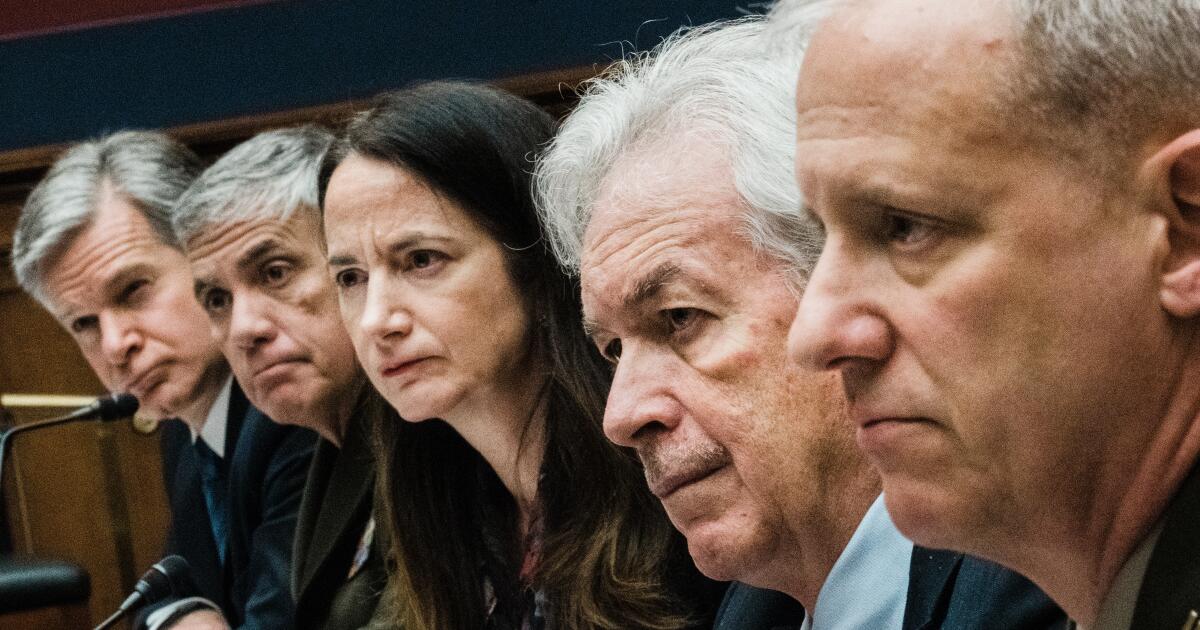WASHINGTON — Russia stood alone Friday to veto a U.N. resolution condemning its “brutal” invasion of Ukraine, killing the measure — for now. But all other members in the solemn session of the U.N. Security Council either voted in favor or abstained, testament to rounds of intensive diplomatic pleas by the Biden administration.
The U.S.-drafted measure, which demands the immediate, complete and unconditional withdrawal of the Russian troops battering Ukraine, was approved by 11 members. Most notably, China, thought to be in Moscow’s corner, abstained. So did two U.S. allies, India and the United Arab Emirates, in a disappointment for the U.S. Russia, as one of five permanent members, holds veto power, which it exercised.
That Russia’s “isolation” was so starkly drawn was hailed as a major victory by U.S. diplomats. And they vowed they will carry a similar resolution to the full 193-member General Assembly, where there are no vetoes and only a simple majority is needed to pass.
The U.S. ambassador to the United Nations, Linda Thomas-Greenfield, said that she was not surprised by the Russian veto but that it would not deter efforts to rebuke and stop Moscow’s aggression.
“Russia, you can veto this resolution, but you cannot veto our voices,” she said, looking directly at the Russian representative, Vasily Nebenzya, who, in one of the peculiarities of U.N. politics, was chairing the session as rotating president of the council.
“You cannot veto the truth,” Thomas-Greenfield continued. “You cannot veto our principles. You cannot veto the Ukrainian people. You cannot veto the U.N. Charter. And you will not veto accountability.”
Nebenzya, after the vote but with the council still in session, took Thomas-Greenfield and several other Western representatives to task for what they had condemned as egregious abuses and attacks on civilians by Russian forces.
“Who are you to moralize?” he said. Thomas-Greenfield looked back at him, stone-faced.
He and the Ukrainian ambassador, Sergiy Kyslytsya, also had testy exchanges. Nebenzya called his Ukrainian counterpart “boorish,” while Kyslytsya said Nebenzya and his comments accusing Ukraine of repression earned him a special “seat in hell.”
Friday’s vote followed senior U.S. diplomats’ intense lobbying of their counterparts from dozens of countries to back the resolution at the Security Council or at a possible later meeting of the full United Nations, where a similar condemnation could be brought.
Russia “will be shown to be isolated on the world stage,” State Department spokesman Ned Price said a couple of hours ahead of the vote.
Although the Americans were disappointed that India and the UAE did not join in the “yes” column, it was China’s decision to abstain that gave them particular relief.
Before Friday’s meeting, U.S. diplomats expressed the likelihood that Beijing would side with Moscow. They saw glimmers of hope, however: President Xi Jinping has been publicly measured in support for the invasion. Although he values a growing relationship with Moscow, he may also be reluctant to pick too bitter a fight with the U.S. and NATO.
The Chinese representative to the Security Council, Zhang Jun, explained his country’s vote saying that although China did not support violating the sovereignty of another nation, as Russia has done, the resolution might add “fuel to the fire” rather than contributing to a diplomatic path to peace. He also said Russia’s “legitimate security aspirations” had to be addressed.
“Ukraine should become a bridge between East and West, not an outpost for confrontation among major powers,” Zhang said.
Similarly, the UAE and India said that although they abhorred Russia’s actions, they feared the resolution would shut the door to diplomacy and dialogue. Both countries, especially India, also have strong ties to Russia.
The Security Council vote came after increased economic sanctions the Biden administration imposed on Russia on Thursday — and on Putin himself on Friday — which had been augmented by a series of measures by the European Union.
Rallying broader support for a condemnation of Russia, however, had been a surprisingly difficult task for U.S. diplomats.
Secretary of State Antony J. Blinken and his deputy, Wendy R. Sherman, as well as other officials, had been on the phone to counterparts from a host of nations, including Portugal, Turkey, Moldova, Israel and Saudi Arabia. Those efforts followed months of in-person and virtual consultations and warnings among allies about Russia’s designs on Ukraine.
India had been an especially prickly case. In addition to historical ties with Moscow, New Delhi in recent years has built a defense and diplomatic partnership with Washington.
But India was tepid in its initial response to Russia’s aggression. During a Security Council session that unfolded in New York on Wednesday night as President Vladimir Putin unleashed Russian troops on Ukraine, India’s representative called for de-escalation but did not condemn Moscow. So, while not a “yes,” India’s abstention Friday could have been worse, diplomats said.
A Biden administration official who briefed reporters on the U.S. strategy for the Security Council rejected any suggestion that the difficulty in putting together a united front reflected the impotence of consensus-based global organizations like the United Nations and especially the Security Council, where Russia and China are permanent members, along with the United States, France and Britain. Russia currently holds the rotating president’s seat on the council.
“It’s important that we send a message to Ukraine, to Russia and to the world that the Security Council will not look away,” said the official, who briefed reporters on condition of anonymity to discuss behind-the-scenes deliberations. “The council was established to respond to precisely this scenario: a stronger country waging war against a weaker neighbor in violation of the U.N. Charter and the principles of the U.N. Charter.”
But U.N. Secretary-General António Guterres, who spoke to reporters after the Security Council meeting, was clearly disappointed.
The United Nations “was born out of war, to end war,” he said. “Today that objective was not achieved.”



